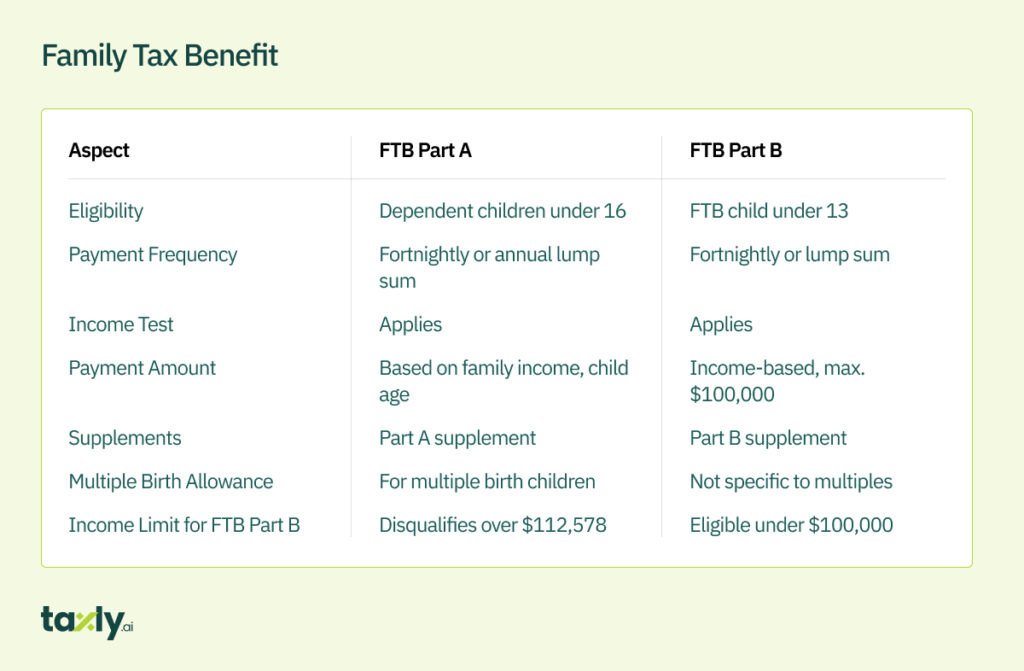Family Tax Benefit (FTB) is a government support program in Australia that provides financial assistance to families, including single parents, to help with the costs of raising their children. FTB has two parts:
Family Tax Benefit Part A:
FTB Part A is a per-child payment that varies based on the family’s income and the ages of the children in your care. The maximum payment for this benefit is approximately $197.96 per fortnight for children up to 12 years and about $257.46 per fortnight for children up to 19 years, if they meet the eligibility criteria. Single parents can receive this benefit if they meet the income eligibility requirements.
For instance, if you are a single parent with a child aged 10, and your income falls within the eligibility threshold, you can receive FTB Part A to help with the costs of raising that child.
Family Tax Benefit Part B:
FTB Part B is a per-family payment designed to provide additional support to single parents, non-parent carers, and some couple families with one main income earner. This part of the benefit recognizes that some parents and non-parent carers may have varying abilities to engage with the workforce due to their specific circumstances and the age of their youngest child. To be eligible for FTB Part B, you must have an FTB child in your care who is under the age of 13.
Single parents automatically receive the maximum amount of FTB Part B if their income is $100,000 per year or less. Additionally, there is a supplement of up to approximately $397.85 per family for the 2022-23 financial year.
For example, if you are a single parent with a child under the age of 13 and your income is below $100,000 per year, you can receive the maximum FTB Part B payment, providing extra financial support to help with the unique challenges of being a single parent.

How FTB Helps Single Parents:
Financial Assistance:
FTB offers direct financial support to single parents, helping them meet the various costs associated with raising their children, from school expenses to healthcare and more.
Childcare Support:
FTB Part A can assist with childcare costs, especially if single parents work or study and use approved childcare services. It can be supplemented by the Child Care Subsidy (CCS) to further ease the financial burden.
Tailored to Family Situation:
FTB is flexible, taking into account your family’s unique circumstances, such as the number and ages of your children. This personalized approach ensures that you receive the appropriate level of support.
Income-Related Assistance:
While FTB has income tests, it’s designed to offer more substantial support to those on lower incomes, ensuring that single parents who need it most receive more significant payments.
Family Tax Benefit Eligibility Criteria:
To be eligible for FTB, you must have a Family Tax Benefit child (FTB child) in your care who is under the age of 16. This ensures that the assistance is directed toward families with dependent children.
Example: If you have a child aged 14, they would qualify as an FTB child, making you eligible for FTB.
Residency Requirements:
You need to be an Australian resident and meet specific criteria, such as Australian citizenship or being a Special Category Visa holder.
Suggested Read: How do I Find my Tax File Number in Australia?
Income Test:
Eligibility for FTB is also determined by an income test. The amount you receive may decrease as your family income increases. The income test ensures that the support is directed towards families who need it most.
FTB Part A income threshold for families with one child was approximately $53,168 per year as of 2022. For FTB Part B, the income limit was around $100,000 for single parents as of 2022.
Application Process:
To access FTB, you must apply for the payment. The easiest and most convenient way to apply is through your myGov account. This online platform streamlines the application process and offers easy access to other government services as well.
You can also automate the entire process by using an AI Powered Tax Assistant App – Taxly.Ai.
Additional Payments and Supplements:
Eligible families may also qualify for various supplements in addition to the basic FTB. These include the FTB Part A supplement, FTB Part B supplement, Newborn Supplement, Newborn Upfront Payment, and Multiple Birth Allowance. These supplements provide extra financial assistance during key life events or unique circumstances.
Income Limit for FTB Part B:
If your annual adjusted taxable income exceeds $112,578, you won’t be eligible for FTB Part B. This threshold is in place to target support toward families with lower incomes.
For example, if you’re a single parent with an annual income exceeding $112,578, you won’t qualify for FTB Part B but may still be eligible for FTB Part A, provided you meet the other criteria.
Family Tax Benefit for Single Parent – Payment Options
Family Tax Benefit (FTB) program offers several payment terms and options to ensure families receive the financial assistance they need. Here are the key payment terms and options:
1. Fortnightly Payments:
FTB payments are typically made on a fortnightly basis, which means you receive money every two weeks.
This regular payment schedule helps families budget and manage their expenses more effectively.
2. Annual Lump Sum Payment:
You can choose to receive your FTB as an annual lump sum after the end of the financial year.
This lump sum payment is reconciled against your actual family income for the year, which may result in a top-up or a debt depending on your circumstances.
3. Mixed Payment Method:
You can opt for a mixed payment method, where part of your FTB is paid fortnightly, and the rest is received as a lump sum at the end of the financial year.
4. Advance Payment:
If you’re facing financial hardship or unexpected expenses, you may be eligible for an advance payment of your FTB.
This allows you to receive a portion of your future FTB entitlement upfront, which is later reconciled against your regular payments.
5. Payment Splitting:
For some families, particularly those with separated parents, the option to split FTB payments may be available.
This allows each parent to receive a portion of the FTB entitlement, depending on their individual circumstances.
6. Indexation:
FTB payment rates are adjusted annually to keep up with changes in the cost of living. It’s important to check the latest rates to ensure you receive the correct amount.
7. Income Testing:
FTB payments are subject to income tests. The amount you receive may decrease as your family income increases. You must report your income to the government, and your entitlement is adjusted accordingly.
For example, if a single parent receives FTB Part A and Part B, they can choose to receive FTB Part A as a fortnightly payment to help with ongoing expenses, while opting for FTB Part B as a lump sum payment at the end of the financial year to maximize their entitlements based on their circumstances.
The Bottomline
The income test for Family Tax Benefit (FTB) in Australia provides support for single parents. If your income is below certain limits, you’re eligible for more FTB support, and the support decreases as your income rises.
Remember that the exact income thresholds can change each year, and your specific entitlement depends on factors like the number of children and the type of FTB you’re applying for. Always check the latest figures on the official government website for the most accurate information.
Explore More Topics


Comments are closed